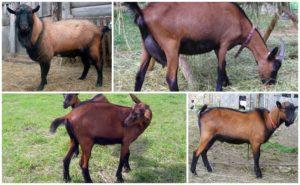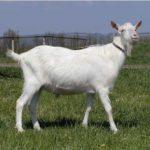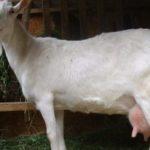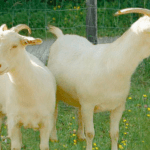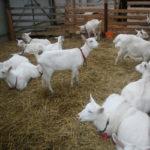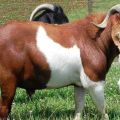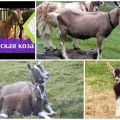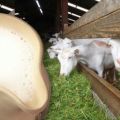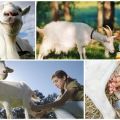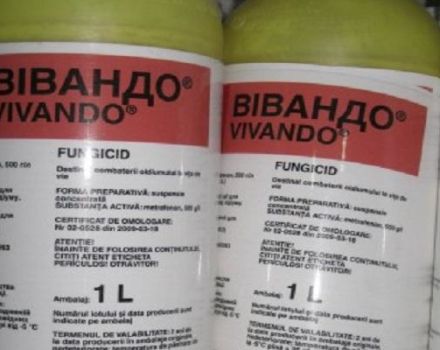Description and characteristics of Megrelian goats, conditions of their keeping
Megrelian dairy goat firmly occupies a place of honor in zoo farms in Western Georgia and Azerbaijan. From the milk of the horned beauty, excellent cheese, delicate cottage cheese and high-quality butter are made. The Megrelian goat does not require increased attention to itself, it very rarely gets sick and is picky about food. The pet is distinguished by rare fertility.
Description and productivity of Megrelian goats
The homeland of adorable animals is cozy sunny Megrelia. The historical corner is located in the western part of Georgia. It was here that the ancestors of the horned beauties lived. The breed combines the best qualities of local dairy goats:
- The representative of the horned tribe is large in size - her height reaches 64-70 cm.
- A strong skeletal system is successfully combined with an elongated body shape.
- By adulthood, the animal is gaining 36-46 kg. The tallest individuals can grow up to 60 kg. The weight of males is 57-60 kg. Large specimens gain weight up to 90 kg.
- The straight back merges into a wide, slightly lowered sacrum.
- The pet's graceful head is topped with a pair of intricately curved horns. Their shape resembles the letter S.
- Erect ears and a neat beard give the animal a cute appearance.
- The slender, strong legs of the goat are equipped with strong hooves.
- The elastic, large udder of the animal is shaped like a cone.
- The coarse, short hair of the pet is colored white or light shades of red, gray and roan.
Megrelian goats are of two types: highland and lowland. The upland type animals are somewhat larger than their fellow tribesmen. The Megrelian goat is extremely fertile and often pleases the owners with the appearance of twins. The pet produces a lot of milk - its annual milk yield is 350-400 kg. With good care and a well-designed diet, milk yield doubles. In some cases, indicators reach 900 kg.
Megrelian goat milk is very tasty and nutritious. The fat content of the product is 4-4.5%. Goat milk is used to make excellent feta cheese, cottage cheese, butter and cheese. The breed is widespread in South Ossetia, Armenia, Georgia and Azerbaijan.
Positive and negative sides of the breed
With all its advantages, the Megrelian goats have some disadvantages. Considering the nuances of the animals, the farmer can achieve good results.

Positive qualities of the breed:
- Goats are extremely picky and prefer to eat pasture. The animals are excellent at fattening up their weight in the highlands and on flat pastures.
- Unpretentious pets do not require special attention and special care.
- Representatives of the Megrelian breed rarely get sick.
Unfortunately, pets do not adapt well to cold climates, so the animals are not suitable for breeding in areas with harsh climatic conditions. This quality can be attributed to the significant disadvantages of the breed.
Features of maintenance and care
The animals are kept in a dry, draft-free goat's house. The room should be spacious. To keep one pet, an area of at least 1.5 m is required.For a goat with offspring, an apartment with an area of 2.5 m is required.It is enough for a male to allocate 2 m, and a growing kid needs a living space of at least 3 m.
In winter, the air temperature in the goat's house is maintained in the range from +6 to -6 degrees. Maintaining the temperature regime is important when there are small kids in the herd. The goats are separated from the females and kept in a separate room.
Keeping animals separate helps avoid unplanned contact. Megrelian goats can be kept in free grazing conditions. In this case, a special canopy is arranged for the animals. Pets hide under cover from the sweltering heat and precipitation. Animals are given plenty of water before being sent to pasture. This technique helps to distract pets from drinking from puddles.
On hot days, animals are watered at least 2 times a day. In winter, goats get a lot of water by eating wet food. During this period, water consumption is reduced, so animals are given warm water only once a day.
In no case should you give cold water to animals that are in a hot state. The procedure threatens animals with colds. Feeders and drinkers are installed at the breast level of adult pets. Dishes for babies are placed just above the floor level. It is forbidden to use feeders made of galvanized material.
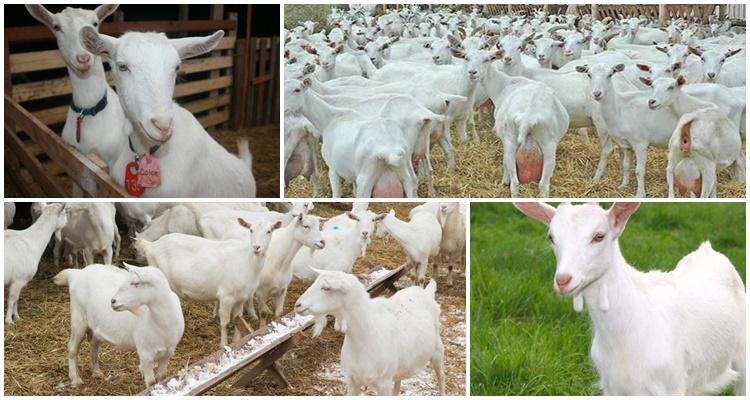
Feeding rules
The usual diet of pets includes barley, oats, corn grains. It is beneficial to feed goats with chopped beets, carrots, cabbage and steamed oats. Adds boiled potato peel to pet food. Compound feed is added to the troughs with cooked food. Fodder salt is poured into special containers. This product is extremely important for the normal development of animals. The additive is put at the rate of: 8 kg of salt per adult. For small kids, the dosage of salt is reduced.
In winter, hay, brooms from deciduous tree branches and pine needles are added to the diet of pets. Nutritious bouquets are hung just above the tops of the animals. This way, pets can reach them. Animal feeding mode:
- In the morning, the goats are given chopped root crops and grain.
- During the day, pets are treated to well-dried hay.
- In the evening, animal feeders are filled with crushed grain and hay.
In summer, goats mainly feed on fresh grass. Animals spend warm months in the highlands, and with the onset of autumn, the animals are sent to graze on the plain.
All about lamb
Pregnancy in a goat lasts 21-22 weeks. Shortly before giving birth, the pet is separated from the herd. The goat's house is disinfected and ventilated. The floor is covered with a thick layer of clean hay. Separate nurseries are being built for future babies. Each kid should have at least 2 m of area. The nursery is equipped with a convenient feeder and drinker.
After lambing, the pet is transferred to a light diet. Typically, a dairy goat calf is artificially fed. To do this, you need to stock up on a bottle and a nipple. On the first day of life, the baby is treated to colostrum. On the next day, every 4 hours, the kid is fed from a bottle with warm fresh milk.After 3 days, the baby begins to give complementary foods in the form of oatmeal. On day 10, the kid is allowed to taste the hay.
For 2-3 months, fresh milk remains the main food for the baby. Then the portions of milk are gradually reduced. If the birth of a goat was in the summer, at the age of 1 month, the baby is sent to a common pasture.
Frequent illnesses
Megrelian goats have strong immunity, but sometimes they can suffer from the following diseases:
- Inflammation of the hoof. The pet falls on a healthy leg and prefers to be in a supine position. Treatment consists in washing the hoof with a weak solution of potassium permanganate and treating the sore spot with iodine and Vishnevsky's ointment.
- Poisoning. Trouble lies in wait for the pet when eating poisonous herbs. The goat is tormented by diarrhea, vomiting. The animal behaves restlessly, sighs heavily, groans and grinds its teeth. First aid consists in gastric lavage. Before the veterinarian arrives, you can give your pet activated charcoal. The rest of the treatment is prescribed by the veterinarian.
- Inflammation of the udder. The disease affects recently lambing goats. The cause of the trouble is hypothermia. A cold compress from a broth of the mother liquor and a gourd will help to cope with the disease.
